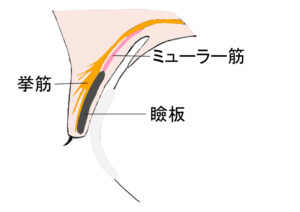eczema
What is ptosis?
As we age, our eyelids become harder to open, and it seems that there are many people who are troubled by this. This is called ptosis. It is said to be more likely to occur in people who have the habit of rubbing their eyelids due to itching caused by allergic conjunctivitis or atopic dermatitis, and in people who have been using hard contact lenses for many years. The exact cause is not known. In general, symptoms tend to worsen with age, and it can be considered a phenomenon of aging. In Japan, the number of patients is on the rise as the population ages.
Symptoms
・Forehead wrinkles
Eyebrows are raised
・Sunken upper eyelids
・Wide double eyelids
When it is only one eye, the wrinkles on the forehead and the height of the eyebrows will be asymmetric. The wrinkles on the forehead will be deeper and the eyebrows will be higher on the side with ptosis.
If you don't lift your chin, it's difficult to see ahead, which can lead to stiff shoulders and headaches.
Patients are usually nervous during their examination, so their eyes are usually open, which can make it difficult to diagnose mild cases.
How to check
1. Relax and close your eyes
2. Hold your eyebrows with your fingers
3. Keep your eyes open
4. If your eyebrows move or try to move upwards, you have ptosis.

There are two main reasons for this:
- Sagging skin
- Weakness of the muscle that opens the eyelids (levator muscle) (in severe cases, the muscle (levator muscle) is detached from the eyelid (tarsal plate))
There are two types:
The only way to cure it is through surgery. Training and massages will not cure it.
The surgery is performed after administering local anesthesia via injection to relieve pain.
1. For this, surgery is performed to remove the loose skin.
There are cases where the skin is cut at the double eyelid position and cases where the skin is cut under the eyebrows. In severe cases, two surgeries are required, but sometimes both are performed at different times. In many cases, the scars become almost invisible.
2. For the above, we adjust the slackness of the muscles that open the eyelids (levator palpebrae superioris and Muller's muscle). If the condition becomes severe and the muscles have become detached from the eyelids, the eyes will not open even if the muscles contract to open the eyes. It will be necessary to sew the muscles and eyelids together.
In addition to 1 and 2, in rare cases, the function of the muscles that open the eyelids may be significantly reduced. In such cases, surgery to open the eyelids using the movement of the eyebrows (connecting the eyelids and the frontalis muscle) may be considered.
The cost of surgery is
If you are covered by insurance and pay 30% of the cost, it will cost around 23,000 yen. In addition, you will need to pay for tests, consultations, prescriptions, etc. If you are covered by insurance, the fee is the same nationwide.
Some people confuse this with double eyelid surgery, but ptosis surgery and double eyelid surgery are separate and unrelated. It is possible to create double eyelids at the same time as ptosis surgery, but there are many people who do not want to have double eyelids at this point. We do not recommend a pronounced double eyelid for elderly people, but please let us know if you would like one. We will explain the procedure while showing you before and after photos.
In addition to the ptosis described above, there is also congenital ptosis in which the eyes are difficult to open from birth.
If the condition is so severe that almost no light can enter the eye, immediate treatment is required as the condition will develop into amblyopia if left untreated. Usually, the obstetrician or pediatrician at the hospital where the baby was born will notice the condition and surgery will be performed in the plastic surgery department to allow light into the eye and prevent the baby from developing amblyopia. The surgery is performed under general anesthesia shortly after birth. If light can enter the eye but the eyelid opening is narrow, the treatment plan will differ depending on the severity of the condition. Treatment for congenital ptosis is performed at a general hospital with inpatient facilities. We refer patients to the Tatsuki Kofukai Medical Research Institute Kitano Hospital.

